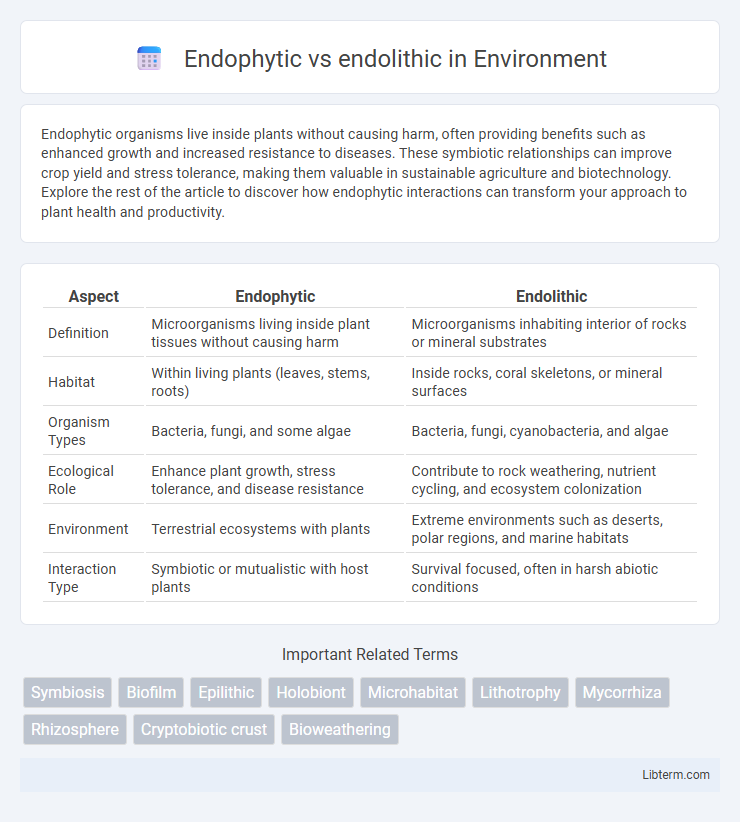Endophytic organisms live inside plants without causing harm, often providing benefits such as enhanced growth and increased resistance to diseases. These symbiotic relationships can improve crop yield and stress tolerance, making them valuable in sustainable agriculture and biotechnology. Explore the rest of the article to discover how endophytic interactions can transform your approach to plant health and productivity.
Table of Comparison
| Aspect | Endophytic | Endolithic |
|---|---|---|
| Definition | Microorganisms living inside plant tissues without causing harm | Microorganisms inhabiting interior of rocks or mineral substrates |
| Habitat | Within living plants (leaves, stems, roots) | Inside rocks, coral skeletons, or mineral surfaces |
| Organism Types | Bacteria, fungi, and some algae | Bacteria, fungi, cyanobacteria, and algae |
| Ecological Role | Enhance plant growth, stress tolerance, and disease resistance | Contribute to rock weathering, nutrient cycling, and ecosystem colonization |
| Environment | Terrestrial ecosystems with plants | Extreme environments such as deserts, polar regions, and marine habitats |
| Interaction Type | Symbiotic or mutualistic with host plants | Survival focused, often in harsh abiotic conditions |
Introduction to Endophytic and Endolithic Organisms
Endophytic organisms reside within plant tissues without causing harm, forming symbiotic relationships that promote plant growth and stress tolerance. Endolithic organisms inhabit the interior of rocks or mineral substrates, thriving in extreme environments by extracting nutrients from inorganic materials. Both types of microorganisms play crucial roles in ecosystem dynamics, biogeochemical cycles, and biotechnological applications.
Defining Endophytic: Life Within Living Tissues
Endophytic organisms live inside the living tissues of plants, forming symbiotic relationships without causing harm. These microorganisms, including bacteria and fungi, inhabit intercellular spaces or vascular tissues, contributing to plant health by enhancing nutrient uptake and stress resistance. Unlike endolithic microbes that colonize inorganic substrates like rocks, endophytes thrive within dynamic, living plant environments.
Understanding Endolithic: Existence Within Mineral Substrates
Endolithic organisms inhabit the microscopic spaces within mineral substrates such as rocks and coral skeletons, adapting to extreme conditions by penetrating and living inside the mineral matrix. Unlike endophytes, which reside primarily in plant tissues, endoliths endure harsh environments by extracting nutrients directly from the mineral environment or via symbiotic relationships with other microorganisms. Understanding endolithic lifestyles offers insights into biological survival strategies in nutrient-poor, high-radiation habitats and contributes to studies in astrobiology and geological bioindicators.
Key Differences Between Endophytic and Endolithic Lifestyles
Endophytic organisms live inside plant tissues without causing harm, engaging in mutualistic relationships that enhance host growth and stress tolerance, whereas endolithic organisms inhabit the interior of rocks, mineral substrates, or coral skeletons, surviving in extreme environmental conditions. Endophytes primarily colonize intercellular spaces or vascular tissues, whereas endoliths penetrate and dissolve mineral matrices to create microhabitats. Metabolically, endophytes often produce bioactive compounds beneficial to plants, while endoliths adapt to nutrient scarcity and high abiotic stress through specialized metabolic pathways like chemolithotrophy.
Ecological Roles and Significance
Endophytic microorganisms live within plant tissues without causing harm, enhancing host resistance to pathogens and environmental stresses through nutrient exchange and secondary metabolite production. Endolithic microbes colonize rocks and mineral substrates, contributing to bio-weathering processes and nutrient cycling in extreme environments by breaking down minerals and facilitating soil formation. Both groups play crucial ecological roles in ecosystem stability and nutrient dynamics, with endophytes primarily influencing plant health and endoliths driving geological and microbial ecosystem interactions.
Adaptations and Survival Mechanisms
Endophytic organisms adapt by living within plant tissues, developing specialized mechanisms such as producing secondary metabolites to evade host defenses and enhance nutrient acquisition. Endolithic organisms survive by penetrating and inhabiting rock substrate pores, evolving robust enzymatic systems and protective biofilms that allow them to withstand extreme conditions like desiccation, UV radiation, and temperature fluctuations. Both utilize unique biochemical pathways and symbiotic relationships to optimize survival in their distinct ecological niches.
Interactions With Host and Environment
Endophytic organisms live inside plant tissues without causing harm, facilitating mutualistic interactions by enhancing nutrient uptake, stress tolerance, and disease resistance. Endolithic organisms reside within rocks or mineral substrates, engaging in symbiotic or protective relationships that enable survival in extreme environments through mineral weathering and nutrient cycling. These distinct habitats influence their interactions, with endophytes primarily affecting plant physiology and endoliths shaping geochemical processes.
Applications in Biotechnology and Industry
Endophytic microorganisms, residing within plant tissues, are extensively utilized in biotechnology for enhancing crop resistance, producing bioactive compounds, and bioremediation, offering sustainable solutions for agriculture and pharmaceuticals. Endolithic microbes inhabit rock or mineral substrates and play a crucial role in biomining, bioremediation of extreme environments, and bioenergy production by facilitating mineral dissolution and nutrient cycling. Both endophytic and endolithic organisms contribute to industrial processes through enzyme production, novel metabolite discovery, and environmental stress tolerance mechanisms.
Research Challenges and Knowledge Gaps
Research challenges in distinguishing endophytic and endolithic microorganisms primarily involve accurate identification due to the overlapping habitats within plant tissues and rock substrates. Limited molecular markers and cultivation techniques impede comprehensive understanding of their ecological roles and interactions. Significant knowledge gaps remain in the metabolic pathways and adaptive mechanisms enabling their survival under extreme conditions.
Future Perspectives on Endophytic and Endolithic Studies
Future perspectives on endophytic and endolithic studies emphasize their potential in sustainable agriculture and environmental biotechnology. Advances in genomic and metabolomic technologies are expected to unveil novel bioactive compounds and stress-resilience mechanisms crucial for crop improvement and ecosystem stability. Integration of interdisciplinary approaches will likely accelerate the application of these microorganisms in bioremediation, crop protection, and climate adaptation strategies.
Endophytic Infographic

 libterm.com
libterm.com